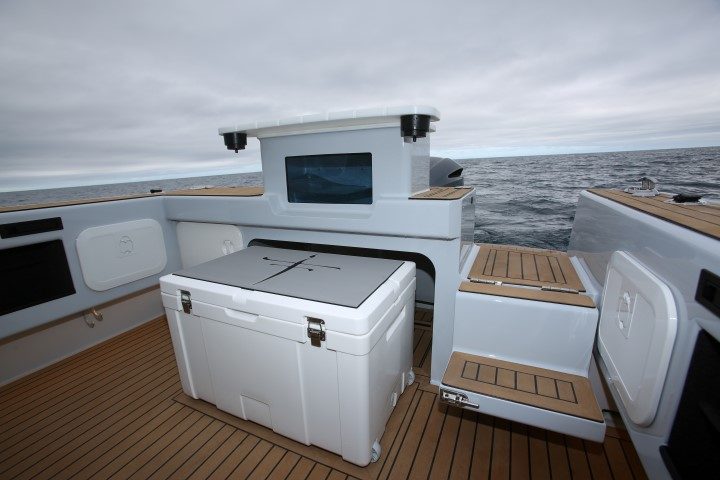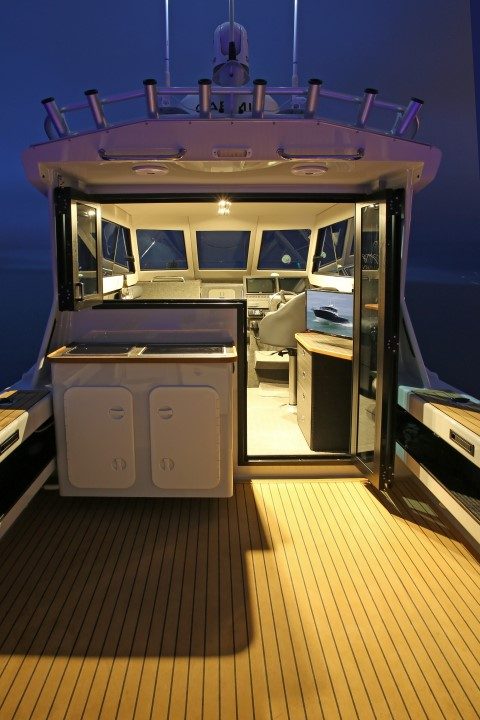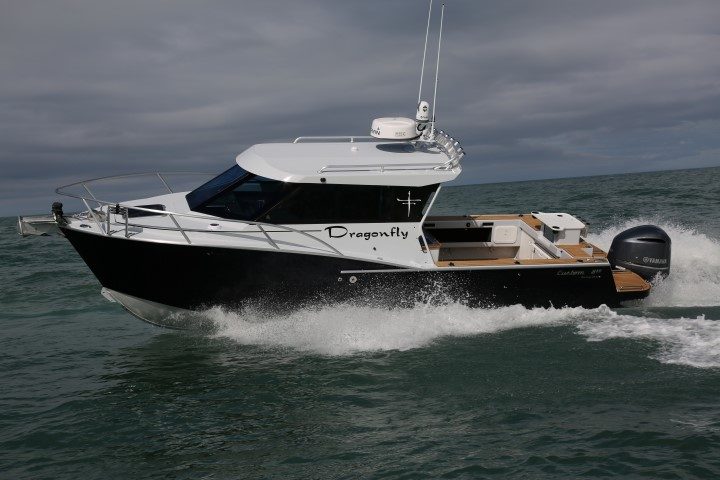She feels really easy and comfortable to sail, even in a good breeze and a chop.

Displaying all the hallmarks of her builder’s precision approach, the Dickey Custom 800 is a quality vessel in every sense of the word.
“I don’t think you’ve ever reviewed this model, John,” Jason Dickey said to me as I climbed aboard a pristine Dickey Custom 800 about to be delivered to its Auckland owner.
He was right. I’ve reviewed most of the Napier-based aluminium boatbuilder’s models, but never the Custom 800, the largest model in Dickey Boat’s trailerable range. The Custom 800 is Dickey Boats’ most popular model with 18 boats now in the hands of owners.
With a number of custom layout options, the Custom 800 can be delivered in either diesel sterndrive or outboard configurations. This boat sports a single 300hp Yamaha four-stroke outboard, which is about the middle of the recommended horsepower range.

Named Dragonfly, this Custom 800 will call Auckland home, and it will be stored at the Orams dry stack in Westhaven. It’s a well-spec’d vessel that presents Dickey Boats’ usual combination of top-quality materials, high-end finish and superb attention to detail. Dickey Boats aren’t cheap but you do get quality design and build for your money.
Great cockpit
With family boating in mind, Dragonfly is configured for day fishing trips, Hauraki Gulf exploring and the occasional overnighter. The self-draining cockpit is extremely workable, with a practical transom layout that Jason and his team has perfected over several Dickey models. The general arrangement is very similar to other trailer boats in the builder’s range, and also the company’s bigger, non-trailerable Semi-Fly models.
There’s a good-sized PVC work area/bait table forming the lid on a large, glass-fronted livebait tank. The bait table features a pair of moulded drink/sinker holders in the front corners, knife slots and there’s enough space for a large Waeco ice bin under the live well. The bin slides away flush with the transom and a locker on the starboard side holds the batteries, fuel filter and associated gear, all neatly arranged, accessible and well secured.

Rod storage comprises a four-position transom rack behind the bait station, six angled through-coaming rod holders and an eight-position rocket launcher on the wheelhouse roof.
If the cockpit awning is deployed – the 800’s supplied with cockpit road cover that converts to a full size sun-shade/cockpit awning which is ideal when camping aboard – the rocket launcher becomes inaccessible. The owner hasn’t bothered with game poles.

Deep side pockets can hold dive bottles. There’s a salt water wash down and a fresh water shower (80 litres capacity), plus fishing tackle storage in dedicated tackle boxes either side.
Dickey’s now familiar thigh pressure activated hand washing system is a feature of this boat too. 12-volt power outlets for electric fishing reels are located just inside the hardtop where they’re protected from the elements, but still handy to the cockpit. USB and 12V DC outlets are found everywhere because, says Jason, “you can never have too many.”
The cockpit sole is covered with smart-looking Dek King G2. It’s lighter and cooler on the feet than the previous generation Dek King, says Jason, who is the New Zealand importer. The cockpit interior is actually painted a shade of grey, but it looks almost white.
It contrasts nicely with the deep blue paint of the hull and the warm, Dek King floor covering. Under the cockpit sole is a 250-litre fuel tank. There’s no underfloor stowage in the cockpit, but there is a good-sized locker under the floor between the seats in the wheelhouse.
Access to the cockpit is via the boarding ladder and step-through with outward opening transom door on the port side. Jason considers inward-opening doors a liability in a bluewater hull which, in a game-fishing role, may need to back up aggressively.
Handrails on the swim platforms double as handy tie-off points. The Dickey 800 features a flooding keel chamber, which makes the boat rock-steady at rest: three bodies standing along one side of the cockpit barely affected the boat’s attitude.
Access to the bows is either by sidling around the hardtop, which is well supplied with handrails and features non-slip surfaces on the side decks, or via a good-sized hatch in the forward cabin.
Standing in the hatchway, the fairlead and Lewmar automatic rope-chain windlass are within easy reach; the anchor locker can be accessed via a hatch in the cabin’s forward bulkhead.
Sociable layout
The 800’s available in several interior configurations. Dragonfly’s owners have opted for a very sociable and attractive arrangement that allows them to open the hardtop to the cockpit, or close it off as desired.
Glass and anodised aluminium bi-fold doors and a window open the rear bulkhead, providing access to the wheelhouse and seating areas inside. The galley is outside, in the cockpit against the wheelhouse bulkhead to port, protected by the cockpit overhang. It features a sink and a two-burner diesel cooker; the boat also has a diesel heater and screen de-misting system. There’s plenty of useful locker space under the galley’s work surfaces.

Inside the hardtop a flexible seating arrangement includes an optional sliding saloon table for better access and the ability to covert the table and the seats around it to a good-sized double berth.
There’s a fridge under the rear seat on the port side and plenty of under-seat storage elsewhere. In the fully-lined forward cabin there’s a full-length berth to starboard with an enclosed heads on the port side, useful shelves and under-berth storage as well.
A flat-screen satellite TV in the wheelhouse and a Bluetooth-equipped Fusion marine entertainment system with speakers in the cockpit and cabin provide pictures and sound.

The helm seat is comfortable. There’s a fold-down bolster for standing support, though I suspect this boat will mostly be helmed from a seated position. The footrest is well placed and the passenger seat opposite the helm has a reversible backrest so its occupant can either face forward or aft.
Sliding side windows provide good ventilation, but close everything up and it’s quiet and cosy inside the hardtop; the heater should provide comfortable, all-seasons boating.
At the helm
We reviewed this boat over two half-days, the first used to get most of the photography and video and the second to give me the opportunity to drive the boat. We were lucky with Napier’s weather on the first day and less so on the second.
For my run we had rain and a rising southerly wind accompanied by a building swell. With the photos out of the way, I had time to get a feel for the boat and was also able to experience her in less than perfect conditions.

The sea state wasn’t bad, though it was deteriorating, but it wasn’t great either and oceanic swells added another element seldom experienced when reviewing boats in the Hauraki Gulf.
Dragonfly took the conditions in her stride, though, providing us with a comfortable, almost serene ride that felt much the same when travelling at 30 knots as it did at 20 knots. Into a head sea the sharp, relatively plumb bow does the work, slicing through the waves.
“Waterline length is everything,” says Jason. “The Custom 800 has maximum hull length with a straight keel line. Long and narrow boats simply go better, which is why the 800 goes exceptionally well for its size.”

With its long waterline length and modest 2.5m beam, the 800 typically rides level, so the first point of contact with a wave is usually the sharp bow. Trim tabs were useful, especially with the wind across the beam, but the boat is soft riding and fairly dry, though spray whipped up by the cross-wind sometimes found its way onto the windscreens. There are no wipers but the glass is coated with Clear Shield.
Down swell, the hull felt relaxed and nicely-balanced, showing no tendency bury the bows into the back of a swell. The chines and raised sheerline pushed most of the spray aside and this boat feels capable of fast, comfortable passages in a variety of conditions. Power steering and electronic throttle and shift provided effortless helming.
Dragonfly’s owners have opted for a powerful Garmin electronics package, including a 15-inch multi-function display (MFD) to present sonar, HD radar and images from the remote-controlled FLIR camera mounted on the hardtop. Although the console has a full suite of Yamaha digital gauges, engine data and diagnostics can also be displayed on the MFD if desired.
We tried the 800 at a variety of speeds. As noted, the boat felt pretty serene no matter what speed we chose, but in the conditions 25 knots felt like a sensible cruising speed. Fuel burn at 21 knots was 1.9 litres per nautical mile, which means Dragonfly’s owners can travel from Westhaven to Great Barrier Island for around $100 dollars of fuel. With sea conditions as they were, we didn’t try a full throttle run, but expect a maximum speed of around 36 knots with this engine.
Bigger is better
This outboard powered version of the Custom 800 impresses with its clever, versatile layout and extremely workable cockpit. Performance and ride are good, as we have come to expect from this builder, and as usual, the manufacturing quality and standard of finish are superb.
In many ways this boat reminded me of the Dickey Custom 750 from which it has evolved, but it benefits from extra length, both in terms of ride quality and usable interior space, and Dragonfly’s enclosed hardtop is definitely a bonus.
She feels really easy and comfortable to sail, even in a good breeze and a chop.
At first glance the boat appears to be a large centre console, although hidden beneath the console and forward area is a sizeable overnight cabin.
With classic styling, good performance and class-leading ride and handling, there’s a lot to like about the Caribbean 32.
Solar panels on the vast roof help keep the batteries charged.